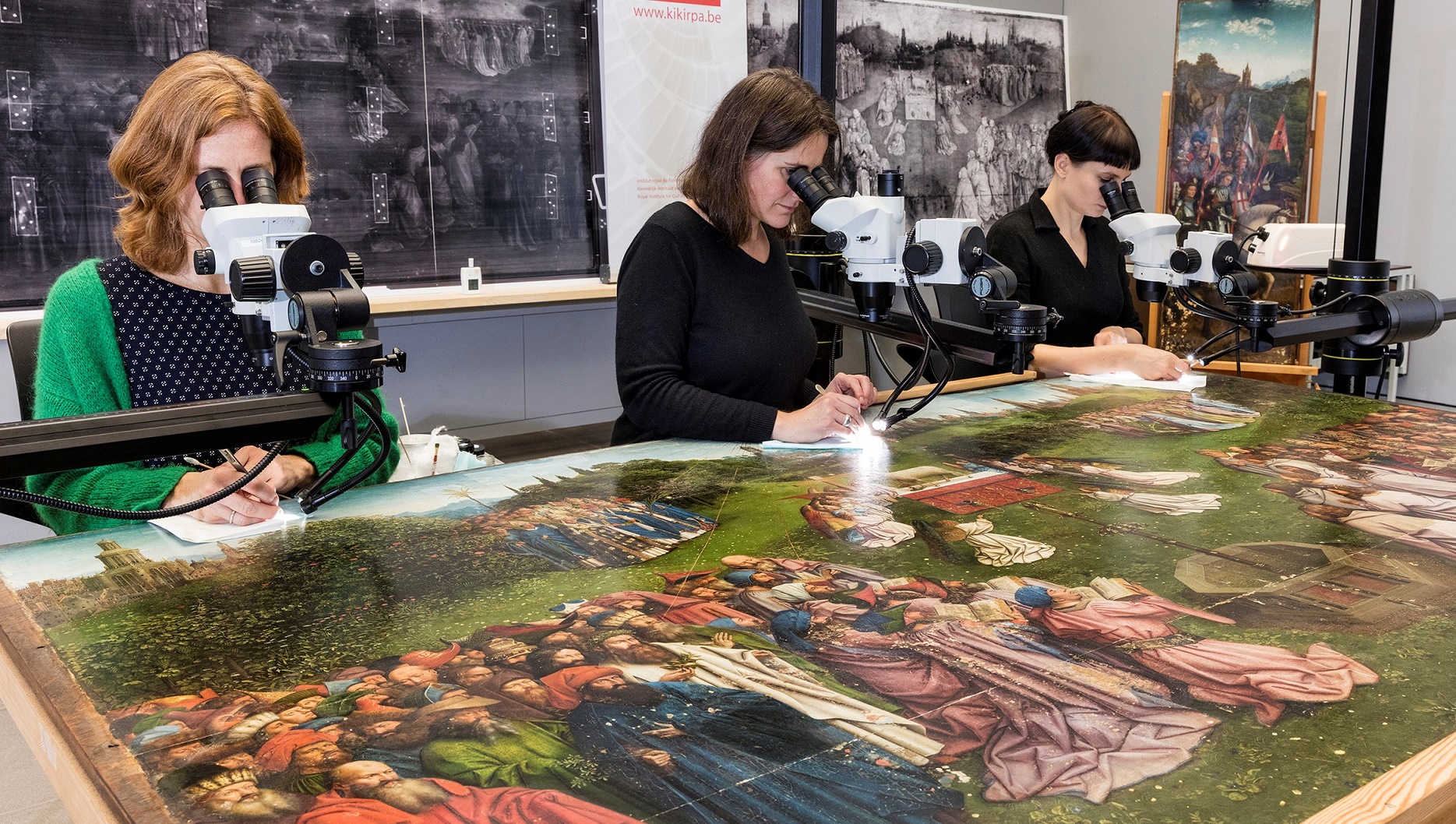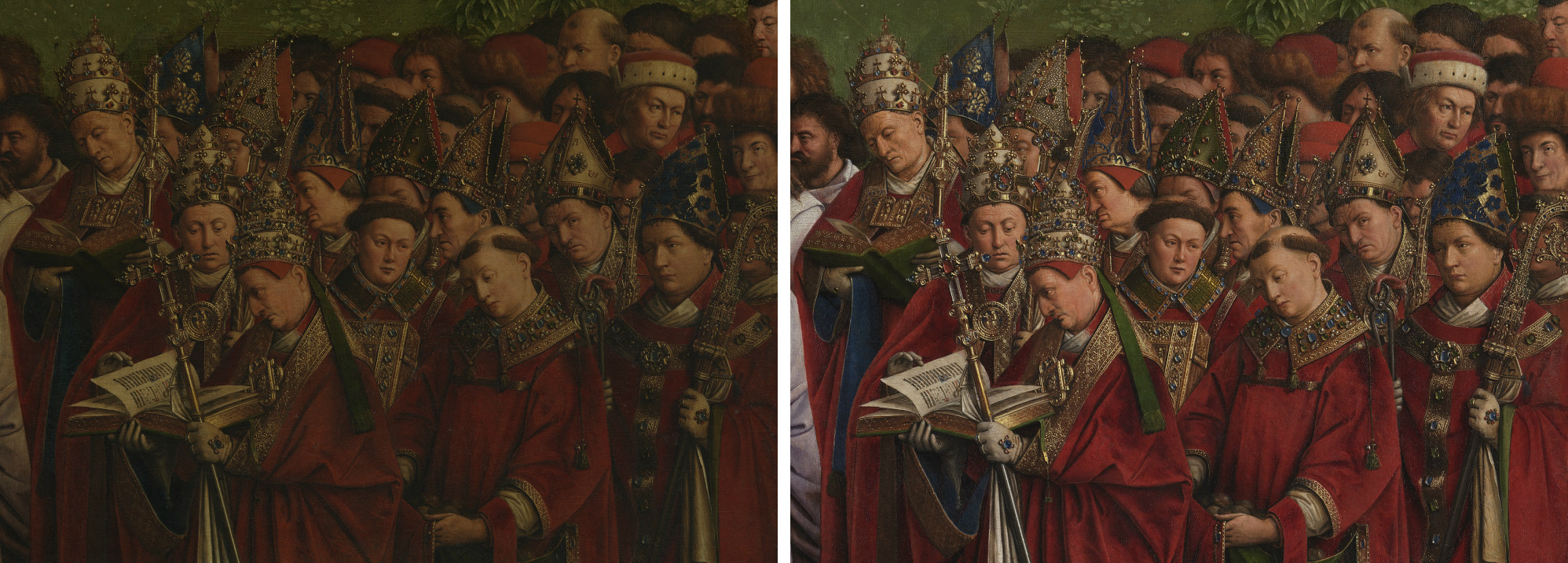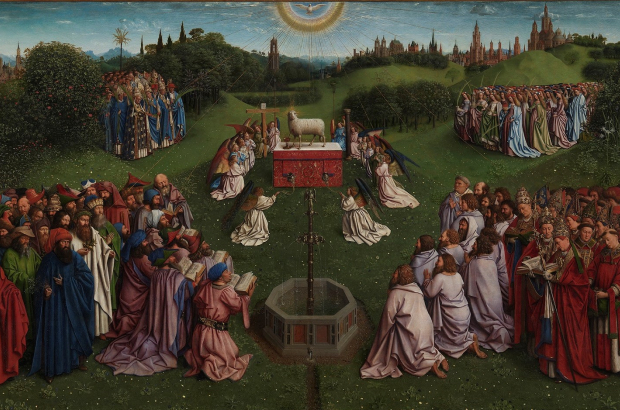- Daily & Weekly newsletters
- Buy & download The Bulletin
- Comment on our articles
Central panel of Ghent Altarpiece fully restored and full of surprises
Phase two of the ongoing restoration of “Adoration of the Mystic Lamb” – otherwise known as the Ghent Altarpiece – is complete. The four lower panels of the altarpiece’s interior – including the coveted centre panel, where the eponymous beast is located – was unveiled this week to press and other guests at Ghent’s Fine Arts Museum.
The results are nothing short of spectacular, with most of Jan Van Eyck’s original 15th-century work now exposed for the first time in at least 500 years. Aside from the vibrancy of the colours due to the removal of varnish, entire new elements of the restored panels have revealed themselves.
Some of the findings beneath the varnish and overpaint have surprised even the specialists carrying out the restoration. The look of Van Eyck’s original lamb itself was already a revelation when it was uncovered last year, “and there were many more things that surprised us like that,” says Griet Steyaert, one of the restorers who has worked on the 20-panel altarpiece over the last nine years. “Some of the buildings in the landscape were completely overpainted. We found a few buildings that we didn’t know existed, that no one has seen for at least 500 years.”
Besides a rendition of the Utrecht Cathedral, most of that background landscape in the prized central panel is inspired by Ghent. Van Eyck painted the altarpiece, which is a two-sided polyptych with doors that open and close, with the assistance of his brother Hubert, on commission from the city’s mayor for the Sint-Baafs cathedral.
Some of the buildings were wiped out by previous conservation efforts, of which there have been many over the centuries. Other artists would simply paint over parts of original works.
50% overpainting
“That was just the way people restored in that time,” explains Steyaert. “They wouldn’t just take a brush and paint over bits that were missing in, for example, a cloak. They’d paint an entirely new cloak. They tried to make it more or less the same, but of course it’s a huge difference.”
Sometimes overpainting was even done to reflect the fashion or trends of a new time. In the case of “Adoration”, a full 50% had been painted over throughout the centuries. In terms of the central panel’s buildings, it was easier to paint sky over them than to try to recreate the bits that had faded or flaked away.
In the end, it turned out that only 5% of Van Eyck’s original work had actually flaked away. The restoration is removing all of the overpaint and varnish – sometimes several layers of each – and laying bare the original work. It is the first time such a restoration has been carried out on the altarpiece, which is one of Europe’s most glorious masterpieces.
Panels of the altarpiece depict many holy figures, including Adam and Eve, Mary, John the Baptist and Christ (or perhaps God). The lower register of the interior of the altarpiece depicts the sacrifice of the Lamb of God, with the lamb at the centre surrounded by a number of groups of pilgrims, including judges, clergy, soldiers and saints.

Restorers at work on the centra panel of the Ghent Altarpiece
“The altarpiece is hugely important, and it always has been,” says Steyaert. “Even in the 16th century, you see that people were coming to see it. And so it is today. It’s really one of the most amazing masterpieces that we have in Europe.”
Van Eyck completed “Adoration of the Mystic Lamb” in 1432, and it changed the course of western art. Not only is it credited with making the use of oil the norm in painting, Van Eyck rendered nature extremely realistically and with as much attention to detail as the figures.
He also employed a much more naturalistic approach than his predecessors or of his own previous works. And it was wholly ambitious – both in scale and in iconography.
“It seems to almost have come out of the blue,” confirms Steyaert. “There’s a huge difference in what people painted before, which was much more stylised. And then suddenly, Van Eyck appeared like this. It’s still a bit of a mystery to try to piece that together, where this came from.”
Discoveries until the end
Steyaert works for the Royal Institute for Cultural Heritage in Brussels, which was charged with studying, planning and carrying out the restoration nine years ago. While the team has changed over the years, she has been with the project since the beginning.
“You know even now, we see things we hadn’t seen before,” she says with a smile. “The last thing we did was the retouching. In the left bottom of the central panel, there is a man with a red cloak, and Van Eyck painted it with a bright vermillion and then he put a dark red glaze over it, and then he dabbed with his brush very, very finely, to give the cloak a texture. That’s a detail that, even after all the cleaning, after all the study, we only saw when we were retouching.”
Retouching is the final step in the restoration process, filling in tiny little cracks using a special magnifying headset. Most of restorers’ work comes before that – the painstaking process of removing centuries of overpaint and varnish.
Once it is determined how many layers you are dealing with on any one part of a panel, a decision has to be made whether to use a solvent to dissolve the layers or to chip them away. “If you use solvents, you start with very gentle ones, going a bit stronger and a bit stronger every time. It involves a lot of testing on a very tiny portion of the painting using a microscope,” explains Steyaert.

Before and after details from the Ghent Altarpiece
If the overpaint is hard, and you can’t dissolve it, that’s when the team pulls out their scalpels, carefully, carefully chipping away. “If there’s a layer of varnish in between, it’s easier. The overpaint will chip off without hurting the paint underneath it. It’s such delicate work that if you do an area of about the size of a business card, that’s a really good day.”
Visitors to the newly restored panels will immediately notice how much brighter they are, with Van Eyck’s bold colours laid bare. But it’s the tiny details that are truly amazing, from buttons appearing on cloaks to lines appearing on faces. And the colour of the sky has altered from a kind of putrid green to a soft blue.
The newly restored panels are on view in the restoration room at Ghent’s Fine Arts Museum and open to visitors on weekends and between Christmas and New Year. But it’s best to wait until 24 January, when they make their debut back in Sint-Baaf’s Cathedral.
On that date, the exhibition The Return of the Lamb will open in the Cathedral, with an educational section and works by contemporary artists. On 1 February, the exhibition Van Eyck: An Optical Revolution will open in the Fine Arts Museum. The panels that can be seen when the altarpiece is closed will be part of that exhibition.
When it closes in April, those panels will be taken back to Sint-Baafs, and all of the altarpiece’s panels will be together again. For now, anyway: In 2021, the third phase of the restoration will begin, and all the panels of the top interior register will be taken to the Fine Arts Museum.
Both the above events are part of Ghent’s Van Eyck Year, which includes many more ways to get to know the Early Netherlandish master. In the meantime, anyone wanting to take a closer look at the altarpiece’s exquisite details can hone in on the panels at the Closer to Van Eyck website.
Photos: Sint-Baafs Cathedral Ghent ©Lukasweb.be-Art in Flanders vzw, photo KIK-IRPA



















